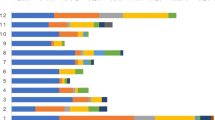Abstract
Human immunodeficiency virus (HIV) infections are prevalent in Thailand. However, the clinical and microbiological characteristics of community-acquired pneumonia (CAP) in such patients are not completely clear at present. In the present study, we analyzed the characteristics of CAP in 191 HIV-infected patients (192 episodes, 130 males and 61 females, mean age 32.9 years, range: 20–62) who had been admitted to Nakornping Hospital in northern Thailand between December 1996 and January 2002. The mean peripheral blood CD4 lymphocyte count was 68.5/mm3 (range: 0–791). The most common organisms detected in the blood of the subjects were as follows: Penicillium marneffei, 13, Salmonella spp., 5, Cryptococcus neoformans, 4, Staphylococcus aureus, 3, and Rhodococcus equi, 3, and the most common organisms detected in sputum included Haemophilus influenzae, 38, P. marneffei, 10, Streptococcus pneumoniae, 10, R. equi, 9, and S. aureus, 9. Life-threatening meningitis in 5 (cryptococcal in 3 and tuberculous in 2), pneumothorax in 2, and tuberculous lymphadenitis in 1 were also noted, resulting in 21 fatalities (10.9%). The mean peripheral blood CD4 lymphocyte count for cases in which the subject died was 74.8/mm3 (range: 0–340). Logistic regression analysis demonstrated that high age (odds ratio of over 40 years: 15.62) and R. equi infection (odds ratio: 8.14) are related to death of HIV-infected patients with CAP. The above findings indicate that various types of organisms, including mixed organisms, cause CAP in HIV-infected patients in northern Thailand, and high age and R. equi infection seem to be risk factors for death.
Similar content being viewed by others
References
Afessa B, Green W, Chiao J, Frederick W. Pulmonary complications of HIV infection: autopsy findings. Chest 1998;113:1225–1229.
Gatell JM, Marrades R, el-Ebiary M, Torres A. Severe pulmonary infections in AIDS patients. Semin Respir Infect 1996;11:119–128.
Murray JF. Pulmonary complications of HIV infection. Annu Rev Med 1996;47:117–126.
Ashley EA, Johnson MA, Lipman MC. Human immunodeficiency virus and respiratory infection. Curr Opin Pulm Med 2000;6:240–245.
Abrams EJ. Opportunistic infections and other clinical manifestations of HIV disease in children. Pediatr Clin North Am 2000;47:79–108.
Phanuphak P. Antiretroviral treatment in resource-poor settings: what can we learn from the existing programmes in Thailand? AIDS 2004;18 Suppl 3:S33–S38.
Phanuphak P, Grayson ML, Sirivichayakul S, Suwanagool S, Ruxrungtham K, Hanvanich M, et al. A comparison of two dosing regimens of zidovudine in Thai adults with early symptomatic HIV infection. Conducting clinical HIV trials in South-East Asia. Aust N Z J Med 2000;30:11–20.
Bartlett RC. Medical microbiology: quality, cost and clinical relevance. New York: Wiley; 1974. p. 24–31.
Vithayasai V, Sirisanthana T, Sakonwasun C, Suvanpiyasiri C. Flow cytometric analysis of T-lymphocytes subsets in adult Thais. Asian Pac J Allergy Immunol 1997;15:141–146.
Jones JL, Hanson DL, Dworkin MS, Kaplan JE, Ward JW. Trends in AIDS-related opportunistic infections among men who have sex with men and among injecting drug users, 1991–1996. J Infect Dis 1998;178:114–120.
Oh MD, Park SW, Kim HB, Kim US, Kim NJ, Choi HJ, et al. Spectrum of opportunistic infections and malignancies in patients with human immunodeficiency virus infection in South Korea. Clin Infect Dis 1999;29:1524–1528.
Chariyalertsak S, Sirisanthana T, Supparatpinyo K, Nelson KE. Seasonal variation of disseminated Penicillium marneffei infections in northern Thailand: a clue to the reservoir? J Infect Dis 1996;173:1490–1493.
Weingarten JS, Huang DY, Jackman JD Jr. Rhodococcus equi pneumonia. An unusual early manifestation of the acquired immunodeficiency syndrome (AIDS). Chest 1988;94:195–196.
Harvey RL, Sunstrum JC. Rhodococcus equi infection in patients with and without human immunodeficiency virus infection. Rev Infect Dis 1991;13:139–145.
Votava M, Skalka B, Hrstkova H, Tejkalova R, Dvorska L. Review of 105 cases of isolation of Rhodococcus equi in humans. Cas Lek Cesk 1997;136:51–53.
Sirisanthana T, Supparatpinyo K. Pulmonary infection caused by Rhodococcus equi in patients with human immunodeficiency virus infection: report of 23 cases from Chaing Mai. J Infect Dis Antimicrob Agents 1996;13:95–99.
Gallant JE, Ko AH. Cavitary pulmonary lesions in patients infected with human immunodeficiency virus. Clin Infect Dis 1996;22:671–682.
Ishida T, Hashimoto T, Arita M, Ito I, Osawa M. Etiology of community-acquired pneumonia in hospitalized patients. A 3-year prospective study in Japan. Chest 1998;114:1588–1593.
Ewig S, Torres A. Severe community-acquired pneumonia. Clin Chest Med 1999;20:575–587.
Navin TR, Rimland D, Lennox JL, Jernigan J, Cetron M, Hightower A, et al. Risk factors for community-acquired pneumonia among persons infected with human immunodeficiency virus. J Infect Dis 2000;181:158–164.
Supparatpinyo K, Perriens J, Nelson KE, Sirisanthana T. A controlled trial of itraconazole to prevent relapse of Penicillium marneffei infection in patients infected with the human immunodeficiency virus. N Engl J Med 1998;339:1739–1743.
Guerrero M, Kruger S, Saitoh A, Sorvillo F, Cheng KJ, French C, et al. Pneumonia in HIV-infected patients: a case-control survey of factors involved in risk and prevention. AIDS 1999;13:1971–1975.
Author information
Authors and Affiliations
Corresponding author
About this article
Cite this article
Watanabe, H., Asoh, N., Kobayashi, S. et al. Clinical and microbiological characteristics of community-acquired pneumonia among human immunodeficiency virus-infected patients in northern Thailand. J Infect Chemother 14, 105–109 (2008). https://doi.org/10.1007/s10156-007-0577-9
Received:
Accepted:
Published:
Issue Date:
DOI: https://doi.org/10.1007/s10156-007-0577-9




